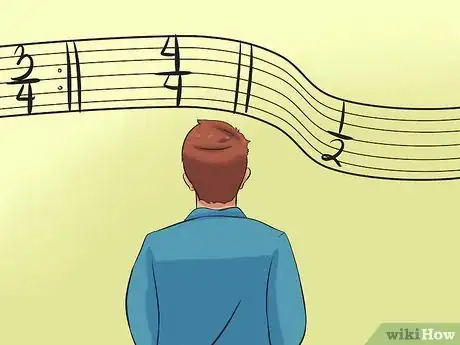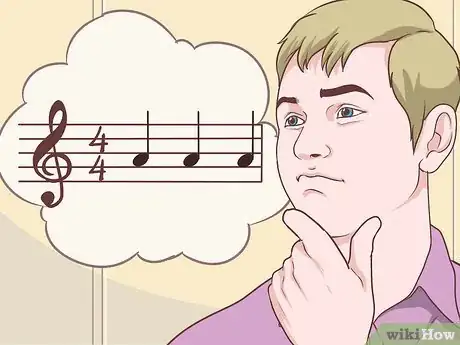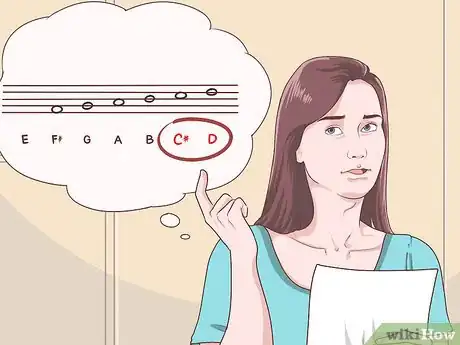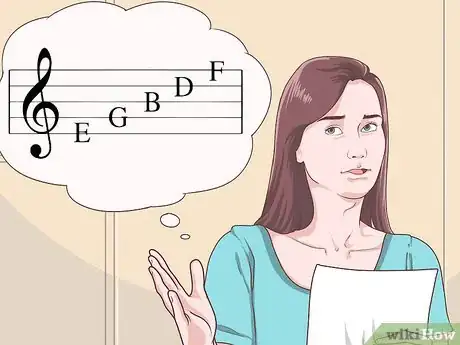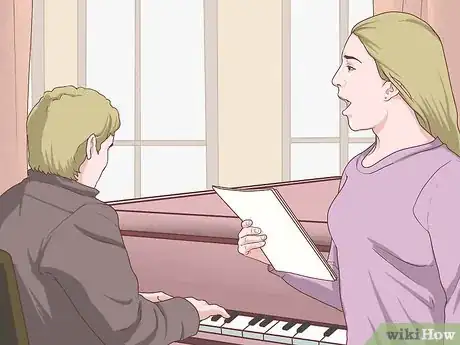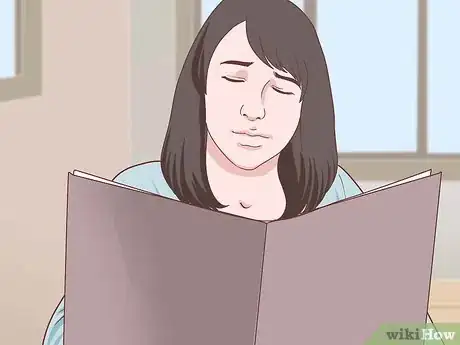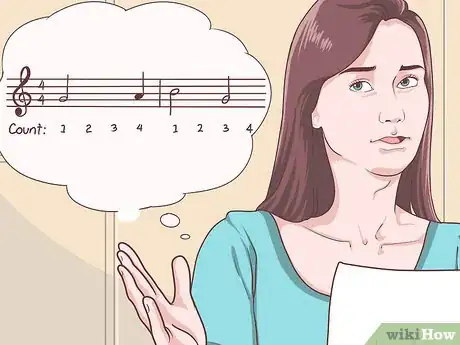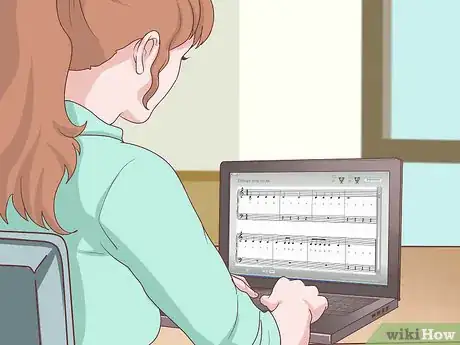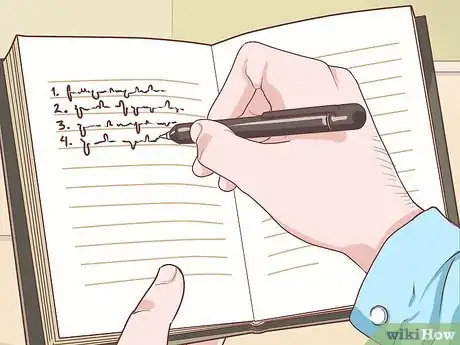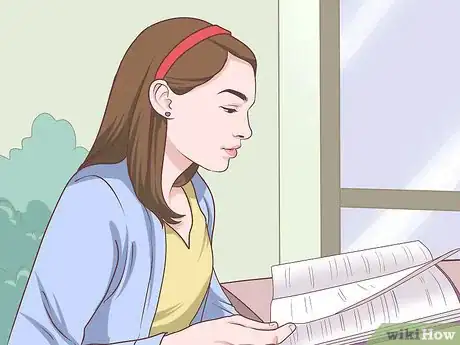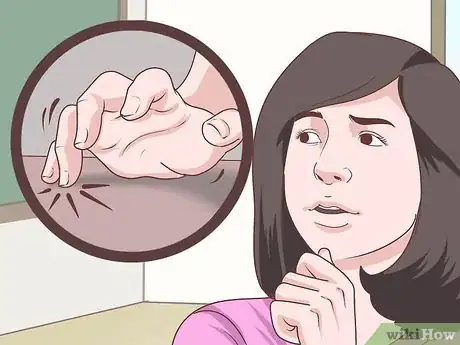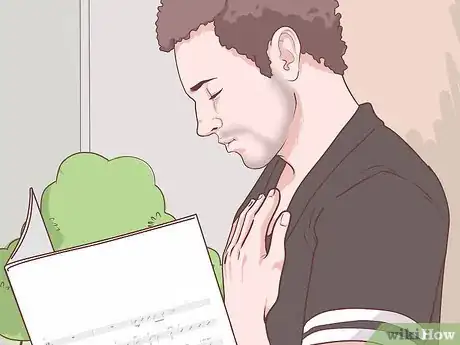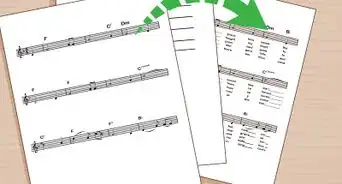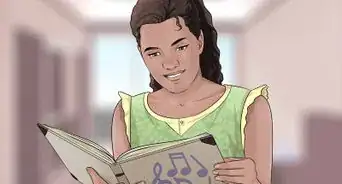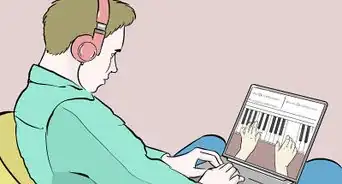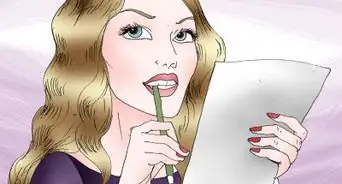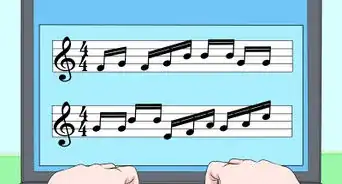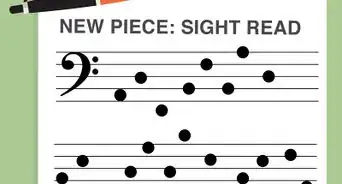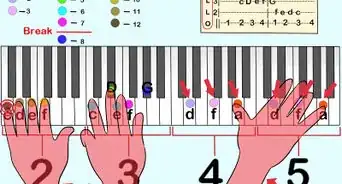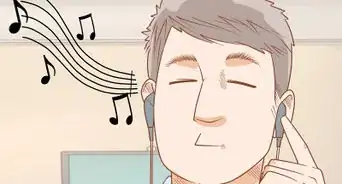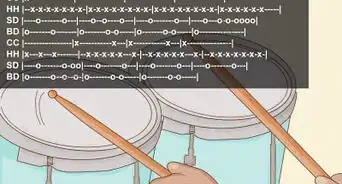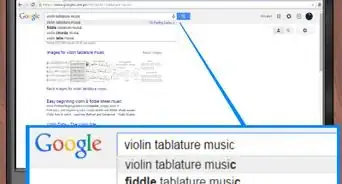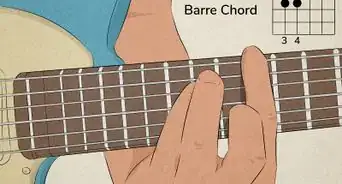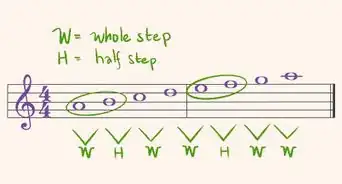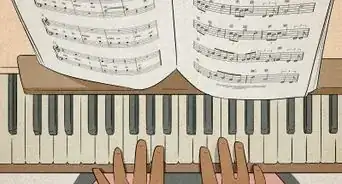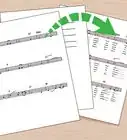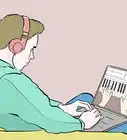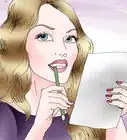This article was co-authored by Michael Noble, PhD. Michael Noble is a professional concert pianist who received his PhD in Piano Performance from the Yale School of Music. He is a previous contemporary music fellow of the Belgian American Educational Foundation and has performed at Carnegie Hall and at other venues across the United States, Europe, and Asia.
wikiHow marks an article as reader-approved once it receives enough positive feedback. This article received 16 testimonials and 80% of readers who voted found it helpful, earning it our reader-approved status.
This article has been viewed 514,772 times.
In order to strengthen your skills as a musician, advance in your craft, and become employable, you must know how to sight read music. Sight reading is an important part of most auditions, and a very necessary part of being able to keep up in an orchestra, choir, or band setting. If you learned to play your instrument or sing by ear, learning to sight read music will help make you a more confident and effective musician and performer.
Steps
Brushing Up on Music Theory
-
1Understand the different types of notes. When sight reading music, you will see whole notes, half notes, quarter notes, eighth notes, and sixteenth notes. These notes are characterized by differing duration, or the length of time the note is played. The whole note is the longest, and they get shorter respectively. For example, a sixteenth note is 1/16 of a whole note.[1]
- While you might think music and math have nothing in common, understanding the different types of music notes is as simple as understanding basic fractions. For example, a quarter note is 1/4 of a whole note. In other words, you can play 4 quarter notes in the time you would play 1 whole note (just as you can play 2 half notes in the time you would play 1 whole note).
- Each note has a different symbol. The parts of the symbols are the head, the round part of the note, the stem, the line that extends from the head, and the flag, the curved line coming off the stem, like a flag.
- A whole note is denoted by just an open note head, without any stem or flag. A half note has an open note head and a stem. A quarter note has a closed (filled in) head and a stem. An eighth note has a closed head, a stem, and one flag, whereas 2 together have a single bar joining them. A sixteenth note has a closed head, a stem, and 2 flags or 2 bars joining as many as 4 sixteenth notes.[2]
-
2Familiarize yourself with time signatures. Time signatures appear on all pieces of sheet music, and they tell you the amount and type of notes in each measure. To put it simply, time signatures tell you the beats of each bar of the song you will be playing.
- When it comes to sight reading, this is the very first thing you will note about a piece, so it's extremely important that you understand time signatures thoroughly. Practice different rhythm exercises to make yourself feel more comfortable working within different time signatures.[3]
- If the time signature is 4/4, that means that each measure contains four quarter notes. The top number refers to the number of beats per measure, and the bottom refers to the type of note being used to measure the beats (in this case, quarter notes).
- A time signature of 3/4 means there are 3 quarter notes, 6/8 means 6 eighth notes, 3/2 means 3 half notes, and so on.
- Use a metronome to help keep track of tempo. A number of pieces will have an M.M. with a number and a note showing; this is the intended approximate tempo after it's fully practiced. Practice at a slower tempo at first, then gradually increase the tempo on the metronome as you get more comfortable with the piece.
Advertisement -
3Memorize key signatures. The key signature is a grouping of signatures that instructs you to play a certain note a half-step higher or lower than you typically would. Basically, the key signature tells you how many sharps or flats may be in the piece, which in turn tells you the key the piece is in, and therefore it's a crucial component of sight reading.[4] The key signature can be found right next to the staff, generally at the beginning of a line of musical notation.
- To read sharp (major) key signatures, look at the last sharp on the key signature and move a half-step above that. So, if the last sharp is a C, the key would be in D major.
- To read flat (minor) key signatures, look at the second to last flat (read the flats left to right). If the second to last flat is E, the song is in E-flat major.
- F major (or D minor) is the exception to this rule as this particular key signature only has one flat (B-flat).
- If the piece is in a minor key, determine what the major key of the piece would be and go down a minor third to identify the major key’s relative minor. For example, the relative minor of G major is E minor, since this is a minor third below G.
-
4Learn where each note falls on the staff. There are 2 types of clefs: treble and bass. The notes look different depending on which clef you’re using. Learn the location of every note on both sets of clefs and practice until you recognize the notes just by looking at them.
- On a treble clef, the line notes spell out EGBDF from bottom to top. Use the mnemonic device, “Every Good Boy Deserves Fudge.”
- On a treble clef, the space notes spell out FACE from bottom to top.
- On a bass clef, the line notes spell out GBDFA from bottom to top. Use the mnemonic device, “Good Birds Don’t Fly Away.”
- On a bass clef, the space notes spell out ACEG from bottom to top. Use the mnemonic device, “All Cows Eat Grass.”[5]
-
5Practice your scales. Practicing scales will help both vocalists and instrumentalists become more familiar with the names of each note and where each note falls on the staff. If you’re an instrumentalist, practice the scales without looking at your hands. This will take a lot of practice to master, but it’s essential for becoming a proficient sight reader.
- If you’re looking at your hands, you’re not able to let your eyes focus on reading the music.
- Instrumentalists should also practice sight singing. This will help you work on phrasing, intonation and musicality.
- Look for key signature changes, repeats, and codas.
Improving Your Sight Reading Skills
-
1Give your full attention to the music in front of you. In other words, act as if every piece of music you are sight reading is the most important thing in the world at that moment, clearing your mind of other daily distractions and worries. Sight reading involves a lot of moving parts – you have to keep track of notes, rhythms, key changes and a thousand other variables. It’s impossible to sight read perfectly without focusing your entire brain on the task at hand.[6]
- Challenge yourself to sight read an entire piece of music without making any mistakes.
- Whenever your mind begins to wander, refocus and start the piece again.
-
2Look for any obvious changes in style, key, tempo, or dynamic. Scan through the piece of music and mark (if you can) any key changes, tempo changes, or change in dynamics.
-
3Divide music into large chunks. When you first begin sight-reading, you may attempt to count every beat, divide every rhythm, and tap maniacally to the beat. Relax! Every piece of music has hundreds of notes and trying to count and identify every single one can be exhausting and impossible. Instead, divide the piece into bigger chunks of music and try to read it that way.[7]
- Cut each measure into 2 parts, and note where the downbeats are. This is a method of interpreting the music in a more relaxed, musical way.
- Now you can look at 2 beats, or even an entire measure, at a time. This is a lot less chaotic than attempting to count each and every beat.
-
4Look for familiar rhythms. While each piece of music you encounter is beautifully unique, there are certainly repeating patterns that you'll continuously encounter. Purchase sight reading practice materials. Children get better at reading words by reading multiple books. Musicians get better at reading music by sight reading multiple pieces. Try going online to sites like Piano Marvel to gain access to sight reading exercises and music pieces you can practice reading.
- Also look online for free sheet music websites.
- Ask your music teacher if they have extra music they’d be willing to let you copy.
-
5Keep a practice journal. Practice often. The best sight readers are musicians who are relaxed and confident in their skills. Becoming an experienced sight reader can take years, but implementing good practice habits is something you can do right now. Try to practice your sight reading for at least 15 minutes every day.
- Write down what you practiced and how long you practiced in your journal.
- Practice sight reading slowly. You can always pick up the pace after you feel more comfortable with the music.
-
6Use drills to improve. Not only will practice drills help you recognize certain patterns and memorize note types, key signatures, and time signatures, it will also help you become a more confident musician. Websites like TheSightReadingProject.com allow you to practice for free online.[8] Grab a cheap music book, flip to a random page, and start sight-reading something. Just like with any skill, the more you sight read, the more confident and proficient you will become. As you feel more comfortable with the basics, you can start fine-tuning your skills.
Preparing to Sight Read
-
1Read through the music. When you first see the piece, take a moment to look it over without your instrument. Try tapping out the rhythm, reading the notes and looking over the structure to see which bars will be repeated. Every time you encounter a new piece of music, you should go through a basic checklist in your head.
- Memorize the key signature, divide the music into chunks, note any repeating rhythms and tricky spots, and tune out the day's distractions.
- Look for any markings that denote changes in speed, volume or accidentals.
- If you have permission, mark these changes on your sheet music using a pencil.
-
2Play through the piece in your head. Take a moment to sound the piece out and look for patterns within the music. See if there are places where the melodies repeat themselves. Study the piece as hard as you can before ever picking up your instrument.
- Look for places in the music where there are scales or arpeggios.
- The more familiar you are with the music, the easier it will be to sight read when you actually have your instrument in hand.
-
3Breathe and brush off mistakes. Sight reading can be overwhelming, but breathing can help you remain focused and can even keep you on tempo. Relax your body and your mind and try to concentrate on the work. Keep going if you make a mistake, because freezing up can only make the problem worse. Make a mental note to practice the part that caused you an issue, and then forget about it. There is more music to play, and you'd be surprised how often an audience misses a small mistake.
- If you are a singer or if you play a wind instrument, use a pencil to mark where you should take a breath.
- Don’t beat yourself up if you don't read the music perfectly your first time out. Sight reading is a skill that takes time to develop.
- Being able to keep going even when you make a mistake is a critical sight reading skill.
Expert Q&A
Did you know you can get expert answers for this article?
Unlock expert answers by supporting wikiHow
-
QuestionHow do you practice sight reading?
 Michael Noble, PhDMichael Noble is a professional concert pianist who received his PhD in Piano Performance from the Yale School of Music. He is a previous contemporary music fellow of the Belgian American Educational Foundation and has performed at Carnegie Hall and at other venues across the United States, Europe, and Asia.
Michael Noble, PhDMichael Noble is a professional concert pianist who received his PhD in Piano Performance from the Yale School of Music. He is a previous contemporary music fellow of the Belgian American Educational Foundation and has performed at Carnegie Hall and at other venues across the United States, Europe, and Asia.
Professional Pianist
-
QuestionWhat does it mean to sight read music?
 Michael Noble, PhDMichael Noble is a professional concert pianist who received his PhD in Piano Performance from the Yale School of Music. He is a previous contemporary music fellow of the Belgian American Educational Foundation and has performed at Carnegie Hall and at other venues across the United States, Europe, and Asia.
Michael Noble, PhDMichael Noble is a professional concert pianist who received his PhD in Piano Performance from the Yale School of Music. He is a previous contemporary music fellow of the Belgian American Educational Foundation and has performed at Carnegie Hall and at other venues across the United States, Europe, and Asia.
Professional Pianist
-
QuestionWhy is sight reading important?
 Michael Noble, PhDMichael Noble is a professional concert pianist who received his PhD in Piano Performance from the Yale School of Music. He is a previous contemporary music fellow of the Belgian American Educational Foundation and has performed at Carnegie Hall and at other venues across the United States, Europe, and Asia.
Michael Noble, PhDMichael Noble is a professional concert pianist who received his PhD in Piano Performance from the Yale School of Music. He is a previous contemporary music fellow of the Belgian American Educational Foundation and has performed at Carnegie Hall and at other venues across the United States, Europe, and Asia.
Professional Pianist
References
- ↑ https://www.musictheory.net/lessons/11
- ↑ https://www.musictheory.net/lessons/11
- ↑ https://www.musictheory.net/lessons/12
- ↑ http://www.dummies.com/how-to/content/how-to-read-key-signatures.html
- ↑ http://artiden.com/how-to-learn-notes-easily/
- ↑ https://www.jazzadvice.com/lessons/5-steps-to-mastering-sight-reading/
- ↑ https://www.jazzadvice.com/lessons/5-steps-to-mastering-sight-reading/
- ↑ http://thesightreadingproject.com
About This Article
If you want to sight read music, start by reading through the piece while tapping out the rhythm and identifying any key changes. Then, divide the piece into large chunks of music, such as by cutting each measure into 2 parts. To improve your reading, look for familiar rhythms in pieces of music you can easily identify or do practice drills by opening a book to a random page. When you feel you're ready to play and read music, read through the piece once more entirely before picking up your instrument. For tips on how to stay calm and relaxed as you read music by using controlled breathing, read on!
